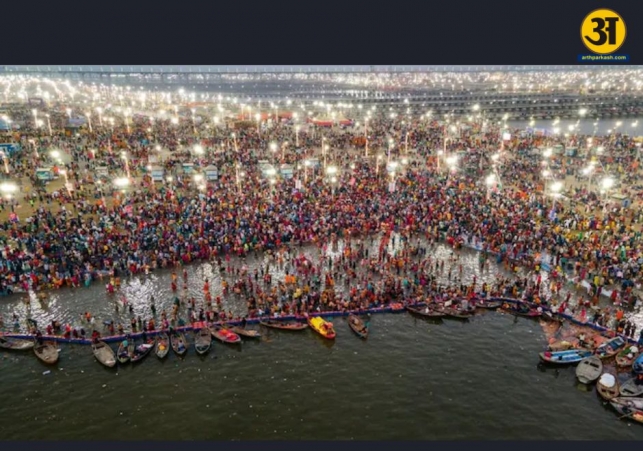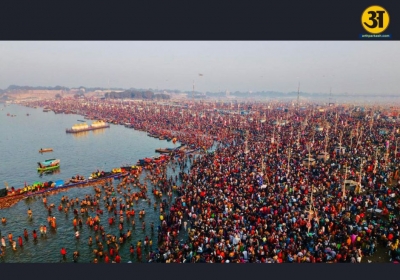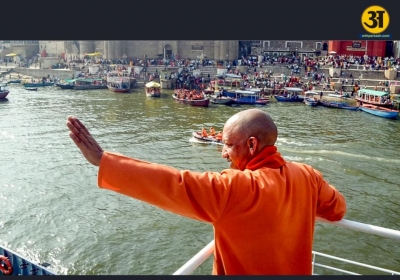
55 crore devotees take holy dip at Maha Kumbh, UP Govt reports
Maha Kumbh: 55 crore devotees have taken holy dip at Sangam, says UP Govt
The ongoing Maha Kumbh Mela, one of the largest religious gatherings in the world, continues to see a monumental rise in participation as devotees from across India and beyond gather at the Triveni Sangam in Prayagraj. According to the Uttar Pradesh government, a staggering 55 crore devotees have already taken a holy dip in the sacred waters of the Triveni Sangam.
The Maha Kumbh, which began on January 13, is scheduled to continue until February 26, coinciding with Maha Shivratri, marking the final bathing ritual. This year’s event has already broken all previous records, both in terms of the sheer number of participants and its significance in the religious, cultural, and social spheres.
The Kumbh Mela, which holds immense importance in Hinduism, is a gathering where devotees come together to immerse themselves in the holy confluence of the rivers Ganga, Yamuna, and the mythical Saraswati. The spiritual belief is that taking a dip in these waters purifies the soul and removes sins.
Massive participation and unprecedented devotion
The total number of 55 crore devotees represents a monumental figure, with nearly half of India’s 110 crore Sanatan Dharma followers already participating in this grand event. The Uttar Pradesh government has released official statements suggesting that the number of devotees who have bathed at the Triveni Sangam represents approximately 50 percent of India’s followers of Sanatan Dharma. This statistic highlights the vast scale of participation and the significance of the Maha Kumbh in the religious landscape of India.
According to the government’s statement, this number is set to increase as the days progress. By the time the final bathing ritual takes place on February 26, the total number of devotees is expected to surpass 60 crore, solidifying this year’s Maha Kumbh as the largest religious gathering in history.
This immense turnout can be attributed to the unparalleled faith and devotion shown by people who journey from every corner of the country to take part in the sacred event. The Kumbh Mela has drawn devotees not only from India but also from overseas, with individuals from different cultural backgrounds coming together to experience this unique and spiritual event.
The Maha Kumbh Mela is regarded as a spiritual homecoming for devotees, an event that transcends geographical boundaries and brings together a community bound by shared religious values and practices. The religious fervor is palpable at the Sangam, where millions of devotees immerse themselves in the waters each day.
For perspective, India’s total population is around 143 crore (1.43 billion), with 110 crore (1.10 billion) followers of Sanatan Dharma, which is commonly referred to as Hinduism. In comparison, more than 38 percent of the country’s total population has already participated in the holy dip at the Triveni Sangam, reflecting the significance of this event in the lives of millions of Hindus across India.
The number of devotees taking part in the Maha Kumbh Mela is also a reflection of the growing interest and awareness of this sacred pilgrimage. The Uttar Pradesh government has highlighted that the event has not only captured the attention of the masses in India but has also drawn participants from across the globe. It has become a symbol of religious unity, devotion, and spirituality on a global scale.
In fact, according to estimates from the Pew Research Center in 2024, there are approximately 120 crore (1.2 billion) followers of Sanatan Dharma worldwide. This means that more than 45 percent of the global Sanatan community has taken part in the sacred immersion at the Triveni Sangam during this year’s Maha Kumbh, emphasizing the global significance of the event.
The scale of participation reflects the deep-rooted spiritual beliefs of millions of individuals who consider the Kumbh Mela an essential part of their religious journey. The large turnout also demonstrates the success of efforts made by the Uttar Pradesh government to facilitate and accommodate such a vast number of pilgrims.
ALSO READ: Women traveling to Prayagraj for Kumbh claim PM Modi allowed ticket-free travel
ALSO READ: AAP accuses centre of covering up New Delhi Station stampede: ‘They are trying to…’
Major days and record-breaking crowds
The Maha Kumbh Mela is known for attracting millions of devotees during specific days that are considered particularly auspicious for taking a dip. One of the most significant days of the event is Mauni Amavasya, which saw an overwhelming turnout of nearly 8 crore devotees. This day marked a peak in participation, and the authorities were prepared to manage the crowds and ensure that all devotees had a safe and spiritual experience.
Another key day for the Maha Kumbh Mela was Makar Sankranti, which also witnessed a massive turnout, with around 3.5 crore devotees participating in the Amrit Snan (holy bath). These auspicious days serve as a focal point for the pilgrimage, drawing in large numbers of devotees who seek the opportunity to purify themselves in the holy waters of the Sangam.
In addition to Mauni Amavasya and Makar Sankranti, several other key days also saw substantial participation. Over 2 crore devotees took part in the holy dip on February 1 and January 30. Paush Purnima, another significant day in the Hindu calendar, saw the participation of 1.7 crore devotees.
The number of devotees continued to rise as the event progressed. On Basant Panchami, around 2.57 crore devotees made their way to the Sangam to take part in the sacred ritual, and more than 2 crore pilgrims took a dip on Magh Purnima. These figures highlight the sheer scale of the Maha Kumbh Mela and its unparalleled importance in the spiritual life of millions of Hindus.
The Maha Kumbh Mela has far-reaching spiritual and cultural significance. It serves as a unifying force for Hindus around the world, who see it as an opportunity to deepen their faith, seek blessings, and purify their souls. The event brings together people from all walks of life, creating a sense of community and shared purpose.
The confluence of the three rivers – Ganga, Yamuna, and Saraswati – is regarded as one of the holiest places on Earth. It is believed that the waters of these rivers hold divine powers that can wash away sins and grant salvation. For millions of Hindus, participating in the Kumbh is a once-in-a-lifetime experience that holds immense spiritual importance.
Beyond its religious significance, the Maha Kumbh Mela also has a deep cultural impact. It is a vibrant celebration of Hindu traditions, rituals, and customs. During the Mela, there are numerous religious discourses, cultural performances, and other activities that showcase India’s rich spiritual heritage. The event draws not only pilgrims but also tourists and researchers interested in understanding the historical and cultural legacy of the Kumbh Mela.
This year’s Maha Kumbh Mela has already surpassed all expectations in terms of the number of devotees participating. Uttar Pradesh Chief Minister Yogi Adityanath had predicted that the event would break records, and so far, that prediction has proven true. The initial estimate was that 45 crore people would attend the Kumbh, but that number has already exceeded 50 crore and is expected to rise to over 60 crore by the time the event concludes.
The Kumbh Mela is a monumental event that has captured the attention of the world, drawing not only religious devotees but also global observers fascinated by its scale and significance. The current year’s event has set a new benchmark in terms of participation, emphasizing the growing importance of the Kumbh Mela as a major religious gathering.
As the Maha Kumbh Mela continues, it is clear that the event holds unparalleled spiritual and cultural significance for millions of devotees. It remains one of the most sacred and largest religious gatherings in the world, with the number of participants growing each year.





